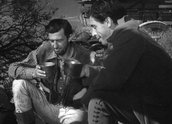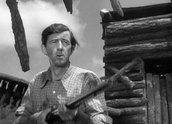


Bitter Springs (1950)
Synopsis
Wally King (Chips Rafferty), with his family and stockmen, drive livestock over hundreds of kilometres of dry country to take up their new selection at Bitter Springs, in central Australia. A government trooper (Michael Pate) warns them that they are moving onto a waterhole that is home to a clan of Aborigines, but King believes he has all the rights. Trouble begins soon after they arrive, when Wally’s son John (Charles 'Bud’ Tingwell) shoots a kangaroo that some Aborigines are trying to spear. Englishman Tommy (Tommy Trinder) and his son Charlie (Nicky Yardley) are abducted, and the Aborigines burn down the makeshift homestead that Scottish carpenter Mac (Gordon Jackson) has built.
Hot-headed John kills a young tribesman in a skirmish and is speared trying to get water. The Aborigines cut the family off from the waterhole to force them out. As they await the final attack, the trooper arrives with reinforcements. He has orders to round up the Aborigines and move them off their traditional lands, an order with which he disagrees. A final shot shows another possibility: blacks and whites working alongside each other in Wally King’s prosperous shearing shed in the future.
Curator’s notes
Bitter Springs is about a bitter history – the clash between white settlers and Indigenous Australians over land and water – and it was made in bitter circumstances, but it remains one of the most interesting films of the immediate postwar era. It certainly deserves to be better known than it is. Ralph Smart, who had produced the hit children’s film Bush Christmas (1947), had his script for Bitter Springs rewritten by head office at Ealing Studios; he was forced to include a role for Tommy Trinder, an English comedian who was completely out of place in the story, and he was not allowed to shoot the ending he wanted. Smart would recall this later as the unhappiest experience of his working life. Nevertheless, the film he made has some remarkable qualities.
It’s sometimes labelled an Ealing 'western’ shot in Australia, but it’s not really that. In truth, no film before this had attempted to be so frank about the ways in which Aborigines were dispossessed of their land in Australia during the previous 170 years. No film had ever tried to present their views on this process, nor shown the ways in which they resisted. If the film had been truly a western, the dispossession would have been barely questioned, but a question of rights and justice is at the heart of Bitter Springs. This is a clash between two powerful groups of people – the whites who have guns and a hunger for land, and the blacks who have spears and traditions. One of the ways in which it differs from a western is that the Aborigines are shown as individuals, rather than being simply the collective enemy. There is a series of powerful close-ups unlike anything in earlier Australian cinema (see clip two).
These close-ups tell us a lot about Ralph Smart’s intentions as director. They indicate a desire to have white audiences in Australia and Britain – the two main markets for the film – see these Indigenous men as fully human, rather than some kind of sub-human devil. Smart is at pains to make it abundantly clear that they have rights and that they are prepared to fight for them. At the same time the film presents a relatively sympathetic view of the pioneering spirit of Wally King and family. They are stoic and hard-working, but largely ignorant of the people and place they are trying to take charge of. King (played by Chips Rafferty) is tough and unsophisticated but firm in his belief that he has obtained the land lawfully. Like many white Australians of the time, he justifies the land grab with disparaging views about stone-age men who do nothing with the land, but he’s slow to fire his gun – unlike his hot-headed son, played by Charles ‘Bud’ Tingwell. Wally’s intentions are not malevolent, so much as immovable and uncompromising.
Charles Chauvel had attempted to look at this history in his film Heritage (1935), but without much success. He would return to the subject of Aboriginal assimilation in Jedda (1955), the first film in which Indigenous Australians are the lead characters, but his film offered a gloomy conclusion about their future. Bitter Springs imposes a much more upbeat view of the future in which black and white work together in King’s shearing shed, but it’s a fairly sentimental ending tacked on at the studio’s insistence. This happy ending avoided the mass slaughter with which a typical American western might have ended – but it was not the ending Smart had wanted. The Aborigines were massacred in his original script; this was considered much too confronting by the Ealing head office. They insisted on finding a lighter tone, even though the ending as filmed still contains a degree of bitterness. Michael Pate’s character points out the injustice of his intervention. He has been told to round up the blacks and move them off Bitter Springs – their ancestral lands. He doesn’t know where they will end up but he says it’s completely unjust.
No Australian film had spoken so pointedly about the politics of conquest in Australian history before; few have tackled the subject even since. The reason is perhaps that Bitter Springs is only nominally an Australian film. It’s really a British film, made with the kind of liberal politics that Ealing Studios was known for. In some ways it was a film ahead of its time, although one reason it was not taken very seriously was the presence of British comedian Tommy Trinder in the cast. Ealing, run by Michael Balcon, had made a considerable amount of money from wartime films in which Trinder cheered up the great British public. He was perhaps included in Bitter Springs as insurance, but his presence almost wrecks the film, because it undercuts the essential seriousness of its subject.
Ralph Smart believed he was imposed on the film because Balcon and Trinder had fallen out, so Balcon did not want to bother finding films for him to do in England. 'Bitter Springs was a very bitter thing for me,’ Smart told David Stratton in a taped interview in the late 1970s that is held at the NFSA. ‘I have never been more unhappy. It was the worst time I have ever had in my life. I certainly realised soon as we started that Tommy Trinder, not in a hundred years did he fit into it. He just was not there… so there was no hope for it. I knew I was sitting on a powder keg and every day it got worse until I was really not in a fit state to make the film at all.’ Filming was also problematic. Smart chose to shoot Bitter Springs in Quorn, South Australia, partly because it almost never rained. Once on location, it barely stopped raining.
Bitter Springs is certainly no masterpiece, but its depiction of the tensions between white settlers and Aboriginal clans is more nuanced than any Australian film before it – and many that came after.
Secondary curator’s notes
by Liz McNivenWith greater social heritage significance than filmic value, Bitter Springs attempts to draw attention to the need for coexistence between Aboriginal peoples and pastoralists, within the expansive lease holdings of inland Australia. It tackles the issue of race relations and conflict over land, water and natural resources in South Australia, at the turn of the twentieth century, during the period of white settlement in the isolated northern region of the state.
The film follows a white family, the Kings, on their journey to take up a lease at a place called Bitter Springs. This otherwise fair-minded family enact an illusion of racial superiority in their encounter with the Aboriginal sovereign owners of the land. The film exposes the ethnocentric attitudes of the settlers and their inept attempt at sharing natural resources with the Aboriginal peoples.
Bitter Springs includes many groundbreaking aspects: the use of the Pitjantjatjara Aboriginal language in the dialogue between the Aboriginal characters and also with the non-Aboriginal character Ransom, the government patrol officer; the attempt to portray the Aboriginal side of the white settler story; a large Aboriginal cast with an Aboriginal man in a central role; the demonstration of Aboriginal agency within the production; and the exposure of white settler arrogance juxtaposed against Aboriginal peoples’ rights to their lands, waters and natural resources. These qualities differ from Australian representation of Aboriginality during the same period. The film’s white characters embody and display a mix of cultured British tolerance and uncultured Australian intolerance.
Before the arrival of whites in Australia in 1788, the British Admiralty Orders to Captain James Cook stated that if the land was inhabited, possession should be taken with the consent of the inhabitants. Despite this order, on arrival to a country inhabited by a diversity of Aboriginal peoples, Cook declared the land to be uninhabited. As a result, Aboriginal lands in Australia were carved up without any form of consent from, or negotiation or treaty with, the Aboriginal sovereign owners of the country.
Aboriginal cosmology acknowledges and values the sacredness of everything in the natural world: the land, waters, rocks, plants and animals. Aboriginal law governed access to and use of these natural resources. Each Aboriginal nation had access to a permanent water supply. In the case of the fictitious 'Karrigari’ people depicted in the film, their waterhole was Bitter Springs. Lands, waters and natural resources provided the foundation for local Aboriginal economies and the frugal management of these resources ensured the survival of the people and the maintenance of their cultural traditions. Bitter Springs highlights the conflicts created when white settlers exploit these resources and marginalise Aboriginal peoples from their country; it advocates a future based on a shared cultural understanding and mutual coexistence.
A poignant moment in the film occurs when the government patrol officer, Ransom (Michael Pate), tells Wally King (Chips Rafferty), 'When whites take over Abo’ land there are three ways of dealing with the natives: one, you can shove them off; two, you can ease them off; and three, you can find some way of taking them in with you. Now, you’ve got to make up your mind what you’re going to do.’ The film then plays out the drama created by one people making their home in another people’s homeland without consent or negotiation.
The unique establishment of the pastoral lease system in Australia contained a mechanism to enable Aboriginal peoples to live on their land in coexistence with white pastoralists. Under this model, many Aboriginal peoples lived and worked on their traditional country, maintaining cultural continuity, while supporting the establishment and development of the pastoral industry in Australia.
- Overview
- Curator’s notes
- Video 3 clips
- Principal credits
- Find a copy
- Comments 1
- Map
- Add your review




